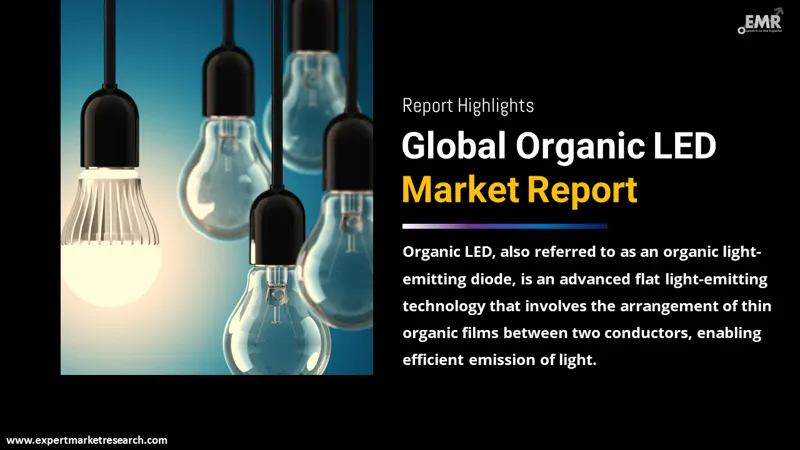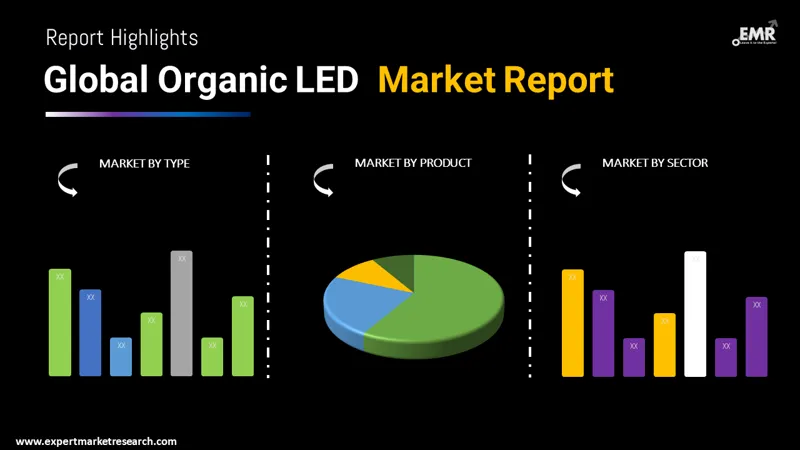
Consumer Insights
Uncover trends and behaviors shaping consumer choices today
Procurement Insights
Optimize your sourcing strategy with key market data
Industry Stats
Stay ahead with the latest trends and market analysis.
The global organic LED market attained USD 68.91 Billion in 2025. The global organic LED market is expected to grow in the forecast period of 2026-2035 at a CAGR of 23.20% to attain USD 555.12 Billion by 2035.
Base Year
Historical Period
Forecast Period
Compound Annual Growth Rate
23.2%
Value in USD Billion
2026-2035
*this image is indicative*
The growing demand for environmentally friendly goods can be a significant opportunity for this industry to expand. The Asia Pacific is leading the organic LED industry, accounting for the majority of the market revenue share.

Read more about this report - REQUEST FREE SAMPLE COPY IN PDF
“Organic LED Market Report and Forecast 2026-2035” offers a detailed analysis of the market based on the following segments:
Market Breakup by Type
Market Breakup by Product
Market Breakup by Technology
Market Breakup by Application
Market Breakup by Sector
Market Breakup by Region

Read more about this report - REQUEST FREE SAMPLE COPY IN PDF
Favourable properties of the product like high productivity, low power utilisation, enhanced image quality, durability, and lightweight are the major factors affecting the organic LED market positively. The Asia-Pacific is leading the organic LED market globally, followed by North America and Europe.
The report presents a detailed analysis of the following key players in the global organic LED market, looking into their capacity, competitive landscape, and latest developments like capacity expansions, plant turnarounds, and mergers and acquisitions:
The EMR report gives an in-depth insight into the industry by providing a SWOT analysis as well as an analysis of Porter’s Five Forces model.




*While we strive to always give you current and accurate information, the numbers depicted on the website are indicative and may differ from the actual numbers in the main report. At Expert Market Research, we aim to bring you the latest insights and trends in the market. Using our analyses and forecasts, stakeholders can understand the market dynamics, navigate challenges, and capitalize on opportunities to make data-driven strategic decisions.*
Get in touch with us for a customized solution tailored to your unique requirements and save upto 35%!
The global organic LED market reached a value of USD 68.91 Billion in 2025.
The market is projected to grow at a CAGR of nearly 23.20% in the forecast period of 2026-2035.
The market is estimated to reach a value of about USD 555.12 Billion by 2035.
The major drivers of the market include rising disposable incomes, increasing population, and the product’s high productivity, low power utilisation, enhanced image quality, durability, and lightweight.
The rising demand for environmentally friendly goods is expected to be a key trend guiding the growth of the market.
North America, Europe, the Asia Pacific, Latin America, and the Middle East and Africa are the leading regions in the market.
The major types of organic LED are flexible OLED and rigid OLED.
The leading products in the market are display and lighting.
The significant technologies of organic LED in the market are passive matrix OLED, active matrix OLED, transparent OLED, top-emitting OLED, foldable OLED, and white OLED.
The major application segments in the market are television and monitors, smartphones, laptops and tablets, and automotive, among others.
The leading sectors in the market are commercial, residential, and industrial.
The leading players in the market are Au Optronics Corp. (TPE: 2409), Cambridge Display Technology Limited, Universal Display Corporation (NASDAQ: OLED), LG Electronics Inc. (KRX: 066570), and Samsung Electronics Co., Ltd. (KRX: 005930), among others.
Explore our key highlights of the report and gain a concise overview of key findings, trends, and actionable insights that will empower your strategic decisions.
| REPORT FEATURES | DETAILS |
| Base Year | 2025 |
| Historical Period | 2019-2025 |
| Forecast Period | 2026-2035 |
| Scope of the Report |
Historical and Forecast Trends, Industry Drivers and Constraints, Historical and Forecast Market Analysis by Segment:
|
| Breakup by Type |
|
| Breakup by Product |
|
| Breakup by Technology |
|
| Breakup by Application |
|
| Breakup by Sector |
|
| Breakup by Region |
|
| Market Dynamics |
|
| Competitive Landscape |
|
| Companies Covered |
|
| Report Price and Purchase Option | Explore our purchase options that are best suited to your resources and industry needs. |
| Delivery Format | Delivered as an attached PDF and Excel through email, with an option of receiving an editable PPT, according to the purchase option. |
Single User License
One User
USD 3,999
USD 3,599
tax inclusive*
Datasheet
One User
USD 2,499
USD 2,249
tax inclusive*
Five User License
Five User
USD 4,999
USD 4,249
tax inclusive*
Corporate License
Unlimited Users
USD 5,999
USD 5,099
tax inclusive*
*Please note that the prices mentioned below are starting prices for each bundle type. Kindly contact our team for further details.*
Flash Bundle
Small Business Bundle
Growth Bundle
Enterprise Bundle
*Please note that the prices mentioned below are starting prices for each bundle type. Kindly contact our team for further details.*
Flash Bundle
Number of Reports: 3
20%
tax inclusive*
Small Business Bundle
Number of Reports: 5
25%
tax inclusive*
Growth Bundle
Number of Reports: 8
30%
tax inclusive*
Enterprise Bundle
Number of Reports: 10
35%
tax inclusive*
How To Order

Select License Type
Choose the right license for your needs and access rights.

Click on ‘Buy Now’
Add the report to your cart with one click and proceed to register.

Select Mode of Payment
Choose a payment option for a secure checkout. You will be redirected accordingly.
Gain insights to stay ahead and seize opportunities.

Get insights & trends for a competitive edge.

Track prices with detailed trend reports.

Analyse trade data for supply chain insights.

Leverage cost reports for smart savings

Enhance supply chain with partnerships.

Connect For More Information
Our expert team of analysts will offer full support and resolve any queries regarding the report, before and after the purchase.
Our expert team of analysts will offer full support and resolve any queries regarding the report, before and after the purchase.
We employ meticulous research methods, blending advanced analytics and expert insights to deliver accurate, actionable industry intelligence, staying ahead of competitors.
Our skilled analysts offer unparalleled competitive advantage with detailed insights on current and emerging markets, ensuring your strategic edge.
We offer an in-depth yet simplified presentation of industry insights and analysis to meet your specific requirements effectively.
Share